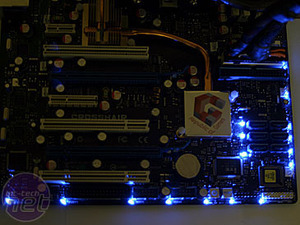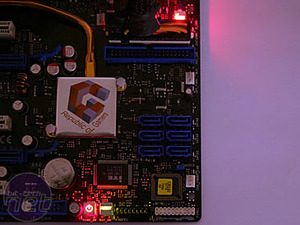

A motherboard without heatpipes these days just doesn't look as cutting edge as the rest, after all, bit-tech always encourages not only being the fastest; you've looking great whilst you do it too. Regardless of the questionable efficiency in a multiple, criss-cross heatpipe system, we can't argue against the fact it looks great. It is highlighted by the typical Asus copper fin array around the CPU area that has adorned the company's motherboards over the last year or so. They do cause a problem if you're using a larger, low sitting heatsink, but taller heatsinks that use heatpipes to elevate the fins should fit without any issues.
The motherboard also sports proper buttons for power and reset, which are not only clearly labelled but also backlit. Pressing the "bulb" button on the rear I/O causes these to go out and instead illuminates a dozen blue LEDs strewn across the board; these are designed to help you to see where to plug in other hardware. The rear I/O in general is very unique: including an LCD display, but we'll come to this more, later.


There are a couple of downsides we can see to this inclusion: they increase cable clutter in your case, making it look untidy, and they also increase the cost of the product. The probe heads are too big be placed in some of the tighter spots in your PC, but that's not something you'd ever really want to do anyway. Overall it's a small price to pay considering the added functionality.
The Crosshair sports three PCI slots, two of which are still usable even if SLI and dual slot coolers are used. This is at the expense of PCI-Express x1 slots, but there’s still a single open ended x4 slot just below the upper most PCI-Express x16 slot. If you are like a lot of enthusiasts, you'll appreciate this massively, because many of you still have a plethora of useful PCI cards and don't want to be forced into upgrading every single component at once. The bottom PCI-Express x16 slot is positioned so it provides extra space between the card above it and itself allowing for more airflow, but this also makes it so low that it will essentially act like a vacuum for the bottom of your case, sucking up all the dust settling.
Asus has left the single PCI-Express x4 slot open ended which means you can install x8 or x16 cards in it. That would be fantastic, but there are two capacitors directly in the way of that open end effectively nullifying any potential gain. It's also somewhat true of the PCI-Express x16 slot above it, where there are a few capacitors right around the clip area you need to pull to get the card out, however these don't directly infringe in any way. There aren't many x4 cards out, but PCI-Express is backwardly compatible so it will support x2 and x1 add-in cards too; or, if you're feeling incredibly brave (and don't care about your warranty) you could de-solder the caps and then resolder them on the back of the board instead.
Most of the capacitors on the board are solid state capacitors which offer an extended lifetime and better power delivery than compared to traditional capacitors, but around the PCI slot area the traditional ones have crept in. That's not to say it's all bad, considering they're high quality KZG capacitors.
The audio has now moved to a separate riser card due to limited space on the rear I/O, however, unlike Abit's solution which causes a loss of the bottom slot space, Asus has moved the audio connector above the top PCI-Express x16 slot, in line with the northbridge. This is a far better use of available space and puts the audio connectors back up near the rear I/O where we are used to them. In addition, offloading the audio from the main PCB onto a daughterboard means better signalling and less interference.

MSI MPG Velox 100R Chassis Review
October 14 2021 | 15:04









Want to comment? Please log in.